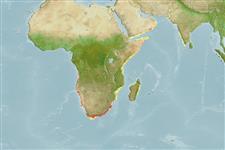Common names from other countries
>
Eupercaria/misc (Various families in series Eupercaria) >
Sparidae (Porgies)
Etymology: Sparodon: Latin, sparus = a fish with a golden head + Greek, odous = teeth (Ref. 45335).
More on author: Castelnau.
Environment: milieu / climate zone / depth range / distribution range
Οικολογία
Θαλασσινό(ά) βενθικό(ς); εύρος βάθους 0 - 80 m. Tropical
Southeast Atlantic: Cape of Good Hope to Natal in South Africa. Also recorded from Djibouti (Ref. 5450) and from Mozambique (Ref. 5213).
Length at first maturity / Μέγεθος / Βάρος / Age
Maturity: Lm 35.0 range ? - ? cm
Max length : 120 cm TL αρσενικό/απροσδιόριστο; (Ref. 3507); common length : 70.0 cm TL αρσενικό/απροσδιόριστο; (Ref. 3507)
Short description
Κλείδες προσδιορισμού | Μορφολογία | Μορφομετρία
Ραχιαίες άκανθες (συνολικά) : 11; Μαλακές ραχιαίες ακτίνες (συνολικά) : 11 - 12; Εδρικές άκανθες: 3; Μαλακές εδρικές ακτίνες: 10. Faint stripes on a greyish body; bluish glow while in water (Ref. 3198).
Inhabits shallow coastal waters, mainly off rocky shores down to 80 m depth. Rarely enters estuaries. Young commonly found in tide pools. Feeds mainly on mollusks (Ref. 5213). An important food fish.
Life cycle and mating behavior
Maturities | Αναπαραγωγή | Spawnings | Egg(s) | Fecundities | Προνύμφες
Smith, J.L.B. and M.M. Smith, 1986. Sparidae. p. 580-594. In M.M. Smith and P.C. Heemstra (eds.) Smiths' sea fishes. Springer-Verlag, Berlin. (Ref. 3198)
IUCN Red List Status (Ref. 130435)
CITES (Ref. 128078)
Not Evaluated
Threat to humans
Harmless
Human uses
αλιεία: Εμπορικό(ά); αλιεία αναψυχής: ναί
Εργαλεία
Special reports
Download XML
Διαδικτυακές πηγές
Estimates based on models
Preferred temperature (Ref.
115969): 18.1 - 28.3, mean 26.8 (based on 204 cells).
Phylogenetic diversity index (Ref.
82804): PD
50 = 1.0000 [Uniqueness, from 0.5 = low to 2.0 = high].
Bayesian length-weight: a=0.01738 (0.00993 - 0.03041), b=2.94 (2.79 - 3.09), in cm Total Length, based on LWR estimates for this species & (Sub)family-body (Ref.
93245).
Τροφικό Επίπεδο (Ref.
69278): 3.8 ±0.0 se; based on diet studies.
Ελαστικότητα (Ref.
120179): Χαμηλό, ελάχιστος χρόνος για διπλασιασμό πληθυσμού 4,5 - 14 έτη (K=0.09; tm=5.4; tmax=26).
Fishing Vulnerability (Ref.
59153): High vulnerability (63 of 100).
